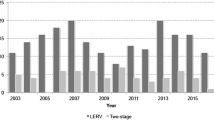Abstract
Background
Although the ideal management of cholelithiasis and concomitant choledocholithiasis is controversial, the two-stage approach [endoscopic retrograde cholangiopancreatography (ERCP), sphincterotomy, and common bile duct (CBD) clearance followed by laparoscopic cholecystectomy] is the most popular treatment regimen worldwide. However, sometimes ERCP fails to solve the problem of choledocholithiasis preoperatively. The aim of this study was to evaluate the use of intraoperative ERCP using the laparoendoscopic “rendezvous” technique in patients in whom preoperative ERCP has failed or was not possible to attempt.
Methods
Twenty-two patients (13 female, nine male), in whom ERCP failed or was not possible to be performed as a separate procedure before laparoscopic cholecystectomy, were treated with the one-stage approach of intraoperative ERCP during laparoscopic cholecystectomy using the so-called laparoendoscopic “rendezvous” technique.
Results
The one-stage approach was completed successfully in a median time of 110 min (range = 75–160 min) in 21 cases; however, in two cases the wire introduced via the cystic duct could not be advanced through Vater’s ampulla into the duodenum and the CBD was cannulated from the endoscopic route, in the usual way. There was no mortality or morbidity and most patients were discharged within 48 h after the procedure.
Conclusion
The laparoendoscopic “rendezvous” is a valuable alternative in treating patients with cholecystocholedocholithiasis. It appears to be a reliable method when preoperative ERCP fails to clear the CBD, while it also offers a one-stage solution to the problem.
Similar content being viewed by others
References
Vaira D, D’Anna L, Ainley C, Dowsett J, Williams S, Baillie J, Cairns S, Croker J, Salmon P, Cotton P (1989) Endoscopic sphincterotomy in 1000 consecutive patients. Lancet 2:431–434
European Association for Endoscopic Surgery Committee (1998) Diagnosis and treatment of common bile duct stones. Surg Endosc 12:856–864
Carr-Locke DL (2002) Therapeutic role of ERCP in the management of suspected common bile duct stones. Gastroinest Endosc 56:170–174
Baillie J, Paulson EK, Vitellas KM (2003) Biliary imaging: a review. Gastroenterology 124:1686–1699
Ausch C, Hochwalter G, Taher M, Holzer B, Rosen HR, Urban M, Sebesta C, Hruby W, Schiessel R (2005) Improving the safety of laparoscopic cholecystectomy: the routine use of preoperative magnetic resonance cholangiography. Surg Endosc 19:574–580
Cuschieri A, Lezoche E, Morino M, Croce E, Lacy A, Toouli J, Faggioni A, Ribeiro VM, Jakimowicz J, Visa J, Hanna GB (1999) EAES multicenter prospective randomized trial comparing two-stage vs single-stage management of patients with gallstones disease and ductal calculi. Surg Endosc 13:952–957
Rhodes M, Sussman L, Cohen L, Lewis MP (1998) Randomized trial of laparoscopic exploration of common bile duct versus postoperative endoscopic retrograde cholangiography for common bile duct stones. Lancet 351:159–161
Enochsson L, Lindberg B, Swahn F, Arnelo U (2004) Intraoperative endoscopic retrograde cholangiopancreatography (ERCP) to remove common bile duct stones during routine laparoscopic cholecystectomy does not prolong hospitalization: a 2-year experience. Surg Endosc 18:367–371
Morino M, Barrachi F, Miglietta C, Furlan N, Ragona R, Garbarini A (2006) Preoperative endoscopic sphincterotomy versus laparoendoscopic rendezvous in patients with gallbladder and bile duct stones. Ann Surg 244:889–893
Lella F, Bagnolo F, Rebuffat C, Scalambra M, Bonassi U, Colombo E (2006) Use of the laparoscopic-endoscopic approach, the so-called “rendezvous” technique, in cholecystocholedocholithiasis. A valid method in cases with patient-related risk factors for post-ERCP pancreatitis. Surg Endosc 20:419–423
Rajnakova A, Goh PM, Ngoi SS, Lim SG (2003) ERCP in patients with periampullary diverticulum. Hepatogastroenterology 50:625–628
Freeman ML, DiSario JA, Nelson DB, Fennerty MB, Lee JG, Bjorkman DJ, Overby CS, Aas J, Ryan ME, Bochna GS, Shaw MJ, Snady HW, Erickson RV, Moore JP, Roel JP (2001) Risk factors for post-ERCP pancreatitis: a prospective, multicenter trial. Gastrointest Endosc 54:425–434
Disclosures
George Tzovaras, Ioannis Baloyiannis, Andreas Kapsoritakis, Athanassios Psychos, George Paroutoglou, and Spyros Potamianos have no conflicts of interest or financial ties to disclose.
Author information
Authors and Affiliations
Corresponding author
Rights and permissions
About this article
Cite this article
Tzovaras, G., Baloyiannis, I., Kapsoritakis, A. et al. Laparoendoscopic rendezvous: an effective alternative to a failed preoperative ERCP in patients with cholecystocholedocholithiasis. Surg Endosc 24, 2603–2606 (2010). https://doi.org/10.1007/s00464-010-1015-0
Received:
Accepted:
Published:
Issue Date:
DOI: https://doi.org/10.1007/s00464-010-1015-0




